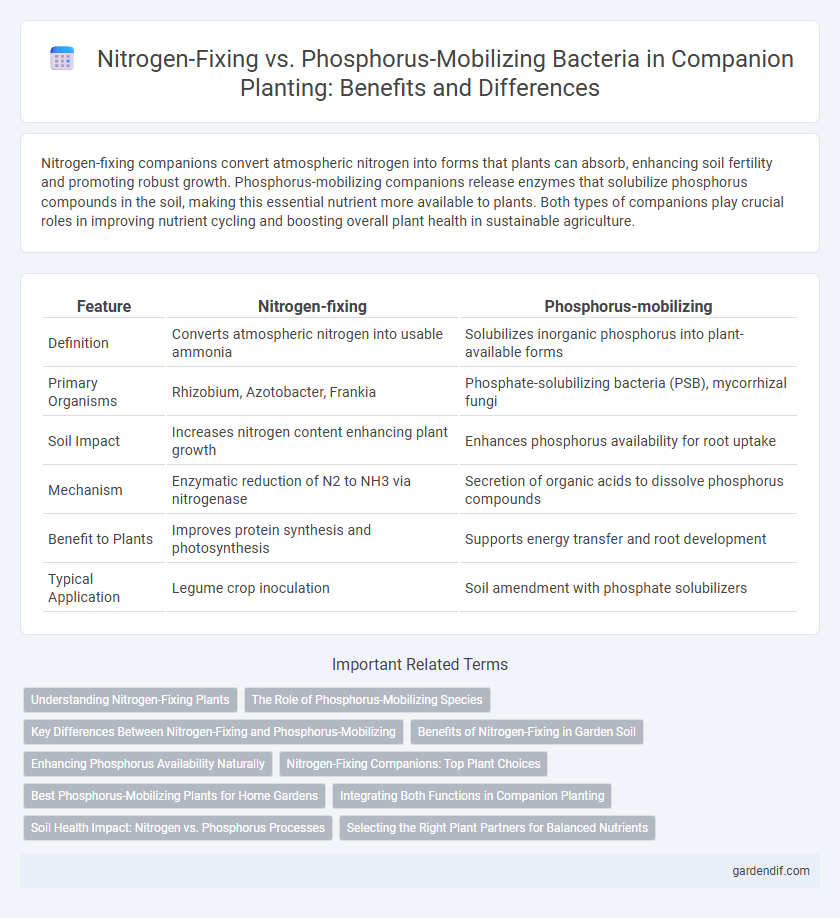
Nitrogen-fixing vs phosphorus-mobilizing Illustration
Nitrogen-fixing companions convert atmospheric nitrogen into forms that plants can absorb, enhancing soil fertility and promoting robust growth. Phosphorus-mobilizing companions release enzymes that solubilize phosphorus compounds in the soil, making this essential nutrient more available to plants. Both types of companions play crucial roles in improving nutrient cycling and boosting overall plant health in sustainable agriculture.
Table of Comparison
| Feature | Nitrogen-fixing | Phosphorus-mobilizing |
|---|---|---|
| Definition | Converts atmospheric nitrogen into usable ammonia | Solubilizes inorganic phosphorus into plant-available forms |
| Primary Organisms | Rhizobium, Azotobacter, Frankia | Phosphate-solubilizing bacteria (PSB), mycorrhizal fungi |
| Soil Impact | Increases nitrogen content enhancing plant growth | Enhances phosphorus availability for root uptake |
| Mechanism | Enzymatic reduction of N2 to NH3 via nitrogenase | Secretion of organic acids to dissolve phosphorus compounds |
| Benefit to Plants | Improves protein synthesis and photosynthesis | Supports energy transfer and root development |
| Typical Application | Legume crop inoculation | Soil amendment with phosphate solubilizers |
Understanding Nitrogen-Fixing Plants
Nitrogen-fixing plants such as legumes form symbiotic relationships with Rhizobium bacteria, converting atmospheric nitrogen into ammonia usable by plants, significantly enhancing soil fertility. Unlike phosphorus-mobilizing plants that release organic acids to solubilize phosphorus, nitrogen-fixers directly contribute essential nitrogen compounds vital for plant growth. Understanding the specific mechanisms and benefits of nitrogen fixation allows for improved companion planting strategies that naturally enrich soil nutrients and reduce the need for synthetic fertilizers.
The Role of Phosphorus-Mobilizing Species
Phosphorus-mobilizing species play a crucial role in enhancing soil fertility by converting insoluble phosphorus compounds into forms accessible to plants, thereby improving nutrient uptake and promoting growth. Unlike nitrogen-fixing species that directly increase soil nitrogen levels, phosphorus-mobilizers primarily enhance phosphorus bioavailability through mechanisms such as organic acid secretion and enzyme production. Their activity is essential in soils with high phosphorus fixation, enabling sustainable plant development and supporting symbiotic relationships in agroecosystems.
Key Differences Between Nitrogen-Fixing and Phosphorus-Mobilizing
Nitrogen-fixing organisms convert atmospheric nitrogen into ammonia, directly enriching soil nitrogen content essential for plant growth, whereas phosphorus-mobilizing organisms solubilize bound phosphorus in the soil, making it available for plant uptake. The primary difference lies in their nutrient targets and biochemical mechanisms: nitrogen-fixers employ nitrogenase enzymes under anaerobic conditions, while phosphorus-mobilizers release organic acids or enzymes like phosphatases to free phosphate ions. Understanding these distinct processes is critical for optimizing soil fertility management and enhancing sustainable agricultural productivity.
Benefits of Nitrogen-Fixing in Garden Soil
Nitrogen-fixing plants enhance garden soil fertility by converting atmospheric nitrogen into forms readily absorbed by roots, promoting robust plant growth and increased yields. This natural nutrient enrichment reduces reliance on synthetic fertilizers, supporting sustainable gardening practices and improving soil structure. Beneficial soil microbes associated with nitrogen-fixing species also boost nutrient cycling and overall soil health.
Enhancing Phosphorus Availability Naturally
Phosphorus-mobilizing microbes play a critical role in enhancing phosphorus availability by solubilizing bound phosphorus compounds in soil, making this essential nutrient accessible to plants. These beneficial microorganisms secrete organic acids and enzymes that release phosphorus from insoluble minerals, significantly improving plant growth and yield. Unlike nitrogen-fixing bacteria, which convert atmospheric nitrogen into usable forms, phosphorus-mobilizing microbes specifically target phosphorus accessibility, complementing nitrogen fixation to optimize overall soil fertility.
Nitrogen-Fixing Companions: Top Plant Choices
Nitrogen-fixing companions play a crucial role in enriching soil fertility by converting atmospheric nitrogen into forms accessible to plants, enhancing growth and yield. Top plant choices for nitrogen-fixing companions include legumes such as clover, alfalfa, and beans, which have symbiotic relationships with Rhizobium bacteria in root nodules. Incorporating these plants into crop rotations or intercropping systems significantly reduces the need for synthetic fertilizers, promoting sustainable agriculture and soil health.
Best Phosphorus-Mobilizing Plants for Home Gardens
Phosphorus-mobilizing plants enhance soil nutrient availability by releasing organic acids that solubilize bound phosphorus, making it more accessible for garden crops. Top phosphorus-mobilizing plants for home gardens include white lupin, chickpea, and buckwheat, known for their ability to thrive in phosphorus-deficient soils and improve nutrient uptake. Incorporating these species as companions in home gardens supports healthier plant growth and increases overall phosphorus efficiency.
Integrating Both Functions in Companion Planting
Integrating nitrogen-fixing and phosphorus-mobilizing plants in companion planting enhances soil fertility by simultaneously enriching nitrogen levels and increasing phosphorus availability, promoting balanced nutrient uptake. Leguminous plants such as clover or beans fix atmospheric nitrogen, while species like white lupin or certain mycorrhizal fungi mobilize phosphorus from soil minerals. This synergistic interaction improves plant growth, yields, and sustainability in agroecosystems by optimizing nutrient cycling and reducing dependence on synthetic fertilizers.
Soil Health Impact: Nitrogen vs. Phosphorus Processes
Nitrogen-fixing microbes convert atmospheric nitrogen into ammonia, enriching soil nitrogen content and promoting plant growth by improving protein synthesis and chlorophyll production. Phosphorus-mobilizing microorganisms solubilize bound phosphorus, enhancing its bioavailability and supporting root development and energy transfer within plants. Together, these processes optimize nutrient cycling, increase soil fertility, and sustain long-term soil health by balancing essential macronutrient availability.
Selecting the Right Plant Partners for Balanced Nutrients
Nitrogen-fixing plants like legumes convert atmospheric nitrogen into bioavailable forms, enriching soil fertility and boosting plant growth. Phosphorus-mobilizing species, including mycorrhizal fungi-associated plants, enhance phosphorus uptake by breaking down insoluble compounds in the rhizosphere. Selecting companion plants that balance nitrogen fixation and phosphorus mobilization optimizes nutrient availability and promotes sustainable agricultural productivity.
Nitrogen-fixing vs phosphorus-mobilizing Infographic

 gardendif.com
gardendif.com